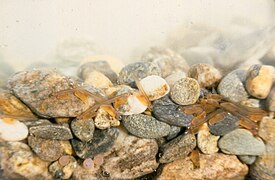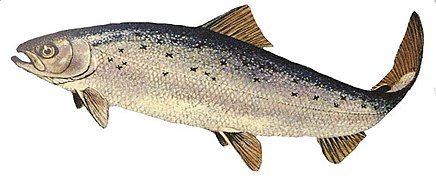Juvenile fish
Growth stages
According to Kendall et al. 1984[2][3] there are three main developmental stages of fish:
- Egg stage: From spawning to hatching. This stage is named so, instead of being called an embryonic stage, because there are aspects, such as those to do with the egg envelope, that are not just embryonic aspects.
- Larval stage: From the eggs hatching till to when ventral side of the spinal cord develops and becomes flexible. A transitional stage known as the sac larval stage, lasts from hatching to the complete resorption of the yolk sac.
- Juvenile stage: Starts when the morphological transformation or sexually matureor starts interacting with other adults.
This article is about the larval and juvenile stage.
- Hatchling – refers to a recently hatched fish larva that is still too immature to achieve motility, and therefore not yet capable of active feeding. A hatchling still possesses a yolk sac upon which it depends for nutrition, and are thus also known as a sac fry.
- Fry – refers to a more developed hatchling whose yolk sac has almost disappeared, and its predators.
- Fingerling – refers to a fish that has reached the stage where the human finger,[5] hence the name. Once reaching this stage, the fish can be considered a juvenile, and is usually active enough to move around a large area. The feeding diet also changes from planktons to invertebrates and algae, occasionally other fish. The fish also starts to morphologically resemble adultfish gradually (though still smaller), although it is not yet achieved sexual maturity.
Juvenile salmon
Fry and fingerling are
- Sac fry or alevin – The life cycle of salmon begins and usually also ends in the eggs are deposited for among the gravels of stream beds. The salmon spawning grounds are also the salmon nurseries, providing a more protected environment than the ocean usually offers. After 2 to 6 months the eggs hatch into tiny salmon larvae called sac fry or alevin. These hatchlings have a yolk sac containing the remainder of the yolkand they stay hidden in the gravels for a few more days, as they are still largely immobile and rely on the remaining nutrients stored in the sac for survival.
- Fry – When the larvae develop further, their yolk sac gets depleted. Once the sac is almost completely gone the larvae must begin foraging for food by themselves, so they leave the protection of the gravel bed and start using their now-stronger tails to swim around feeding on plankton. At this point these mobile alevins become fries.
- Parr – When a fry has grown to roughly the size of a carnivorous diet and quickly gain body mass, and at the end of the summer they develop into juvenile salmon called parr. Parr feed on small invertebrates and are camouflaged with a pattern of spots and vertical bars. They remain in this stage for up to three years.[6][7] Some older male parr are even already able to fertilize adult females' eggs in the spawning season, without having passed through the subsequent stages of development, and compete to do so with much larger anadromous adult males returning from the sea.[8]
- Smolt – As they approach the time when they are ready to migrate out to the sea, the parr lose their camouflage bars and undergo a process of physiological changes that allows them to survive a shift from freshwater to saltwater environments. At this point these young salmon are called smolt. Smolt spend time in the estuaries while their body chemistry adjusts (osmoregulation) to the higher salt levels they will encounter in the ocean.[9] Smolt also grow silvery scales with countershading, which visually confuse ocean predators.
- Post-smolt – When they have matured sufficiently in late spring and are about 15 to 20 centimetres long, the smolt swim out of the rivers and into the sea. There they spend their first year as post-smolt. Post-smolt form schools with other post-smolt and set off to find deep-sea feeding grounds. They then spend up to four more years as adult ocean salmon while their full swimming and reproductive capacity develops.[6][7][9]
-
Salmon eggs. The growing larvae can be seen through the transparent egg envelope. The black spots are the eyes.
-
Salmon egg hatching into a sac fry. In a few days, the sac fry will absorb the yolk sac and become a salmon fry
-
Sac fry remain in the gravel habitat of their redd (nest) while their yolk sac, or "lunch box" is depleted (click to enlarge)
-
The juvenile salmon, parr, grow up in the relatively protected natal river
-
The parr lose their camouflage bars and become smolt as they become ready for the transition to the ocean
-
Salmon enter the ocean as post-smolt and mature into adult salmon. They gain most of their weight in the ocean
Protection from predators
Juvenile fish need protection from predators. Juvenile species, as with small species in general, can achieve some safety in numbers by schooling together.[10] Juvenile coastal fish are drawn to turbid shallow waters and to mangrove structures, where they have better protection from predators.[11][12] As the fish grow, their foraging ability increases and their vulnerability to predators decreases, and they tend to shift from mangroves to mudflats.[13] In the open sea juvenile species often aggregate around floating objects such as jellyfish and Sargassum seaweed. This can significantly increase their survival rates.[14][15]
As human food


Juvenile fish are marketed as food.
- estuaries and sometimes up rivers where they can be easily caught with fine meshed fishing nets. Whitebaiting is the activity of catching whitebait. Whitebait are tender and edible, and can be regarded as a delicacy. The entire fish is eaten including head, fins and gut. Some species make better eating than others, and the particular species that are marketed as "whitebait" varies in different parts of the world. As whitebait consists of fry of many important food species (such as herring, sprat, sardines, mackerel, bassand many others) it is not an ecologically viable foodstuff and in several countries strict controls on harvesting exist.
- Elvers are young critically endangered.[16] Glass eels are even younger eels than elvers, the stage in eel life history when eels first arrive in rivers and swim upstream from the sea in which they hatched. Because the eel cannot be farmed, eels have instead been caught from the wild as juveniles and reared in captivity for human consumption, reducing the wild population further.[17] Like whitebait, elvers are now considered a delicacy and are priced at up to 1000 euro per kilogram. A small serving of Spanish angulas (literally: "eels"), for example, can cost the equivalent of US$100, and other species which can be purchased cheaply are prepared and eaten as "angulas" instead.[18][19] Glass eels are regularly smuggled out of Europe having been harvested illegally for Asian and Russian consumers; smugglers can earn millions of pounds sterling.[20][21][22] Elvers reach a higher price in China than does beluga caviar.[23] The Marine Conservation Society advises against buying European eels.[17]
See also
- Fish development
- LarvalBase – global online database on fish eggs and juvenile fish
- Spawning
Notes
- ^ What are Ichthyoplankton? Southwest Fisheries Science Center, NOAA. Modified 3 September 2007. Retrieved 22 July 2011.
- ^ ISBN 978-0-520-24653-9.
- ^ Kendall Jr AW, Ahlstrom EH and Moser HG (1984) "Early life history stages of fishes and their characters"[permanent dead link] American Society of Ichthyologists and Herpetologists, Special publication 1: 11–22.
- ^ a b Guo Z, Xie Y, Zhang X, Wang Y, Zhang D and Sugiyama S (2008)
Review of fishery information and data collection systems in China[ISBN 978-92-5-105979-1.
- ^ fingerling Oxford dictionary. See: Origin. Accessed: 11 February 2020.
- ^ a b Bley 1988
- ^ a b Lindberg 2011
- PMID 11595048.
- ^ a b Atlantic Salmon Trust 2011
- ISBN 978-0-415-37562-7
- ^ Boehlert GW and Mundy BC (1988) "Roles of behavioral and physical factors in larval and juvenile fish recruitment to estuarine nursery areas" American Fisheries Society Symposium, 3 (5): 1–67.
- ^ Laegdsgaard P and Johnson C (2000) "Why do juvenile fish utilise mangrove habitats?" Journal of Experimental Marine Biology and Ecology, 257: 229–253.
- ^ Hunter, JR and Mitchell CT (1966) "Association of fishes with flotsam in the offshore waters of Central America". US Fishery Bulletin, 66: 13–29.
- ^ Kingsford MJ (1993) "Biotic and abiotic structure in the pelagic environment: Importance to small fishes" Bulletin of Marine Science, 53(2):393-415.
- ^ a b "European Eel - Anguilla anguilla | Marine Conservation Society". www.mcsuk.org. Retrieved 7 January 2020.
- ^ Basque food: Angulas Retrieved 14 February 2012.
- ^ Randolph, Mike. "Why baby eels are one of Spain's most expensive foods". www.bbc.com. Retrieved 11 January 2020.
- ^ "Illegal eel exporters exposed by Countryfile". 15 June 2019. Retrieved 7 January 2020.
- ISSN 0261-3077. Retrieved 7 January 2020.
- ^ "Salesman smuggled £53m worth of live eels". BBC News. 6 March 2020. Retrieved 7 March 2020.
- ^ Gregory-Kumar, David (12 April 2017). "Illegal elvers worth more than caviar". BBC News. Retrieved 7 March 2020.
References
- Atlantic Salmon Trust Salmon Facts Retrieved 15 December 2011.
- Bley, Patrick W and Moring, John R (1988) Freshwater and Ocean Survival of Atlantic Salmon and Steelhead: A Synopsis" US Fish and Wildlife Service.
- Lindberg, Dan-Erik (2011) Atlantic salmon (Salmo salar) migration behavior and preferences in smolts, spawners and kelts Introductory Research Essay, Swedish University of Agricultural Sciences.







